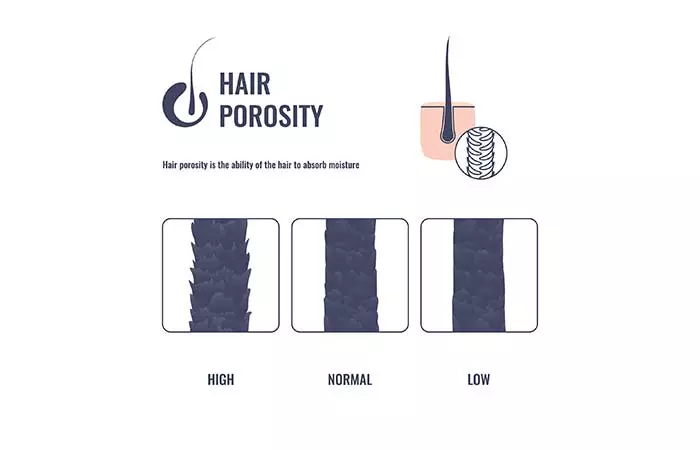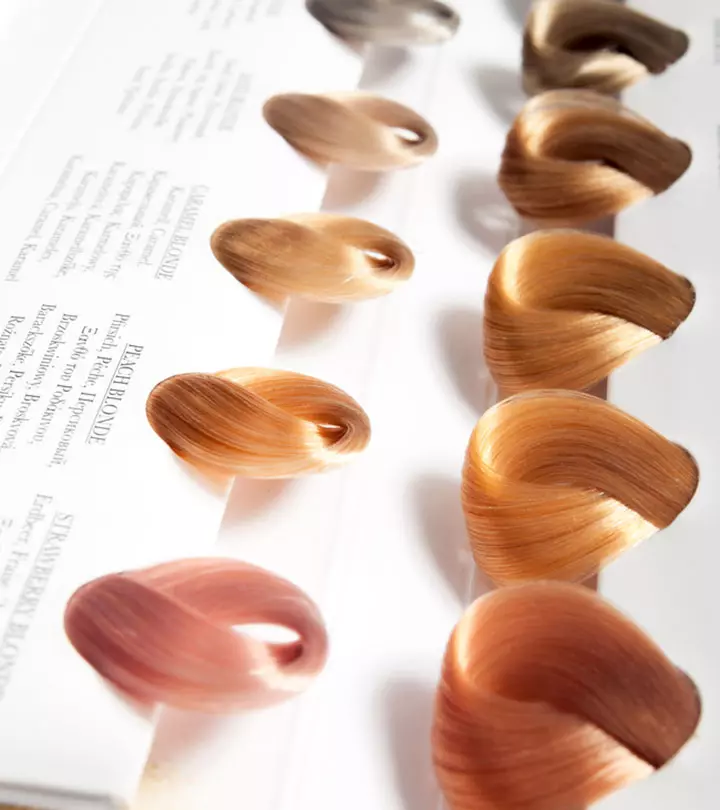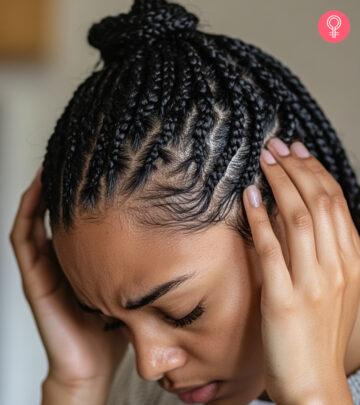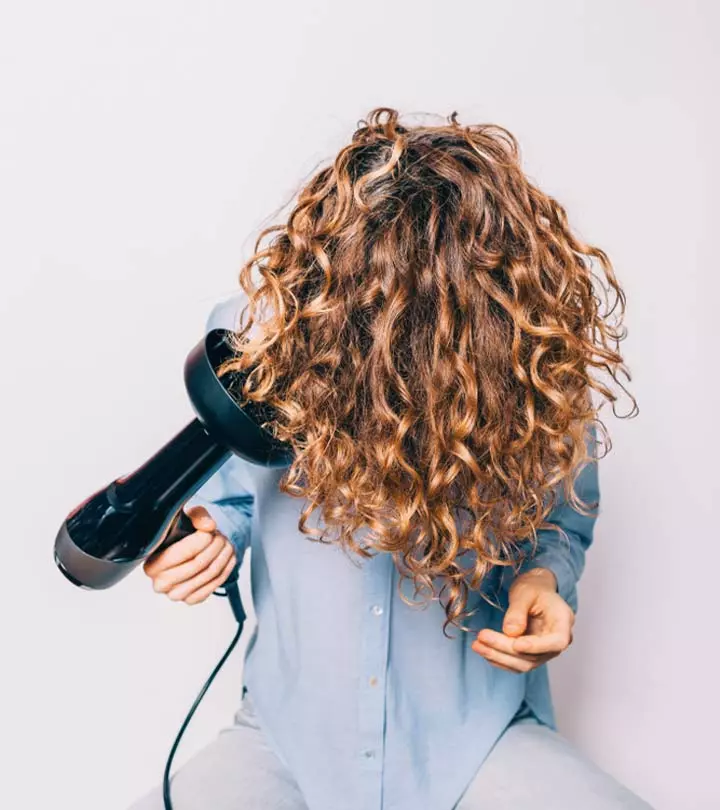Hair Porosity: Types, Causes, And How To Determine Its Level
It's all about how well or poorly your hair strands absorb and retain moisture.

Image: Shutterstock
You may find that your hair takes too long to dry after washing. Sometimes even high-end hair products don’t work the way that you expect. This may be related to your hair porosity levels. Porosity plays a big role in how your hair behaves and reacts to styling products.

You can keep your hair healthy by determining your hair porosity levels to combat tangles, frizz, and dryness. This article provides some fun methods to check hair porosity levels and explores why they are important. Scroll down.
In This Article
What Is Hair Porosity?
Hair porosity is commonly referred to as your hair’s ability to absorb and retain moisture, but it is much more complicated than that. More importantly, is the direct result of how the hair was built (poor nutrition can have consequences on how our hair develops), and also because of thermal, chemical, mechanical, and environmental damage. Any hair type can become dry and dull according to lifestyle, diet, maintenance, and where you live. However, extensively damaged hair strands are highly porous (1). Knowing your hair porosity level helps you choose the right hair care products and treatments suitable for your tresses. In the next section, let’s take a look at the different levels of hair porosity.
Key Takeaways
- Understanding your hair porosity helps you choose the right hair care products and treatments for your tresses.
- Low and high porosity hair can be genetic.
- Medium porosity hair responds well to styling, coloring, and other chemical treatments.
Types Of Hair Porosity

1. Low Porosity
has tightly closed cuticles and resist moisture absorption into the hair shafts. This hair type takes time to absorb moisture, making it prone to buildup and excess oil accumulation on the scalp. Low porosity hair can lock in moisture for a long time and looks healthy and shiny. However, you have to be careful and follow the proper maintenance regimen.
2. Normal Or Medium Porosity
The cuticles in normal porosity hair are slightly elevated but not too open. As a result, this hair type absorbs and retains the right amount of moisture and appears healthy, lustrous, and voluminous. Normal or medium porosity hair requires the least amount of maintenance. It allows you to experiment with different hairstyles and coloring processes.
3. High Porosity
The cuticles in highly porous hair are widely placed and open. As a result, such hair can absorb moisture readily and cannot retain it. This makes it dry and brittle. Highly porous hair is prone to tangles, frizz, and breakage. High porosity hair is often extremely damaged thus requiring a good hair care routine consisting of protein-rich treatments and deep conditioning to control unwanted frizz. You may also consider avoiding the frequent use of heat-styling appliances that can increase dryness.
A YouTuber shared five different ways to test hair porosity levels. She emphasized the importance of testing multiple methods for a more accurate result. She demonstrated different ways of determining the porosity including the absorption test, the hair and body test, the float test, and the strand test. She said, “If the product sits on top of your hair without fully absorbing into your strands, then it’s likely you have low porosity hair. If it fully absorbs into the hair but feels dry within a short space of time, then you have high-porosity hair. But if the moisture lasts all day, then it’s likely you have normal porosity hair (i).”
You can have low, normal, or high porosity hair for numerous reasons. Let’s find out what they are.
Causes Of Low Or Highly Porosity Hair
Both low and high porosity hair can be genetic. However, multiple reasons can make your hair highly porous. These include (2):
- Thermal Damage: Due to Frequent heat styling
- Chemical Damage: Due to overprocessing (chemical treatments and bleaching)
- Environmental Damage: Excessive UV exposure, hard water, excessive heat or cold
- Mechanical Damage: Traction (excessive hair pulling in certain hairstyles), using a brush with bent or damaged bristles.
- Poor Nutrition: Crash diets, Eating only one meal a day, No water
There are ways to manage your hair porosity (discussed later in the article). But, before that, you should know your hair porosity levels. Here are a few ways to determine that.
How To Determine Hair Porosity Levels
1. The Float Test

- Put a few hair strands in a bowl of room temperature water.
- Ensure that your hair strands are clean and do not contain any residue.
- Observe them for about 2-4 minutes.
- If the strands sink immediately to the bottom, your hair is highly porous. If they sink slowly, it means you have normal hair porosity. If your hair floats on the surface or just below the water level, it means it has low porosity.
2. The Slip And Slide Test
- Slide a hair strand between your index finger and thumb, starting from the tip towards your scalp.
- If you feel that the slide is bumpy, you have high hair porosity, and if the slide is smooth, you have low hair porosity. If the slide is slightly bumpy, your hair porosity is normal.
3. The Spray Bottle Test
- Pick a hair strand and spray water on it.
- If the water droplets sit on the surface, forming beads, you have low hair porosity. If the water gets absorbed quickly, you have high hair porosity. If the water stays on the surface for a while and gets absorbed, you have normal hair porosity.
Apart from these popular tests, you may take the following tests to confirm the results. Check them out below!
4. Products Test
Take note of the pace at which hair products get absorbed into your hair. If the products get absorbed at a very fast pace, you have high hair porosity. If they sit on the surface for a long time, you have low hair porosity. If the products are working somewhere in between, you have normal hair porosity.
Consider your hair type (curly, wavy, straight) while taking this test. This is because curls may have a tendency to absorb hair products quickly (because of high porosity), while straight hair may take more time to absorb them.
5. Hair Drying Test

Dampen your hair and see how long it takes to dry. High porosity hair dries quickly, while low porosity hair takes a long time to dry. If your hair dries at an average pace, you have normal hair porosity. However, the drying time may also vary depending on hair thickness. For instance, fine hair dries faster.
6. Shine Test
Low porosity hair is usually lustrous and reflects light, while highly porous hair looks dull. If your hair is moderately shiny, you have normal hair porosity.
7. Tangle Test

If your hair gets tangled easily and is difficult to detangle, you have high hair porosity. If your hair is easy to manage, you have low hair porosity. If your hair is somewhere in between, you have normal hair porosity.
8. Protein Test
High porosity hair is the most receptive to protein treatments and shows quick results. If your hair is not receptive to protein treatments, you have low hair porosity. Normal porosity hair responds to such treatments in a balanced manner.
Once you have determined your hair’s porosity level, the next step is to figure out how to take care of it. Let us see how to take care of low, normal, and high porosity hair types.
Take Care Of Your Hair According To Its Porosity Levels

Low Porosity Hair
Since low porosity hair is moisture-resistant, here’s what you can do:
- Use argan, coconut, and jojoba oils to moisturize your hair. For best results, heat the oil for a few seconds before massaging it onto your hair and scalp.
- Use a clarifying shampoo once a week to remove all the product buildup on your hair and scalp.
- Pamper your hair once a week every two weeks with conditioning hair masks that contain avocado, banana, and olive oil.
- Try to wash your hair twice per week using shampoo, conditioner and leave-in conditioner.
- Do not use an excessive amount of product on your hair, and distribute it evenly throughout the hair.
 Quick Tip
Quick TipNormal/Medium Porosity Hair
Normal/medium porosity hair receives the right amount of moisture. You can use any nourishing and conditioning shampoo and hair masks for it. This type of hair responds well to all styling, coloring, and other chemical treatments. However, avoid frequent chemical treatments and bleaching as it may damage the hair.
High Porosity Hair
High porosity hair requires extra care as it is susceptible to breakage, damage, dryness, frizz, and tangling. Here’s what you can do to nourish and protect it:
- Use a leave-in conditioner every alternate day to retain the hair moisture and prevent dryness.
- Massage your hair and scalp with jojoba, olive, avocado, or coconut oil regularly to nourish and moisturize and improve hair elasticity.
- Avoid using heat styling tools and hairsprays.
- Rinse with cold water to prevent frizz.
 Quick Tip
Quick TipKnowing your hair porosity helps you adjust your hair care routine and make it work for your hair. It is the best way to tackle hair issues like breakage, and dullness at the core. Try the tests mentioned in the article to determine your hair porosity level and keep your hair healthy.
Infographic: 5 Ways To Determine Your Hair’s Porosity Level
Understanding your hair’s porosity can significantly influence how you hydrate, condition, and treat your hair for optimal health and shine. Low-porosity hair has tightly bound cuticles that resist moisture absorption, medium-porosity hair absorbs and retains the right amount of moisture, and high-porosity hair attracts moisture quickly but loses it fast. Check out the following infographic for five effective ways to determine your hair porosity levels.
Some thing wrong with infographic shortcode. please verify shortcode syntaxHair porosity is the hair’s ability to absorb and retain moisture. Curly hair types and damaged hair are very porous. There are three levels of hair porosity – high, normal, and low. Once you figure out your hair porosity, you can buy hair products and learn hair care tips that improve your hair texture and quality. This reduces the chances of hair damage, hair loss, and breakage. Try the tests mentioned above to check your hair porosity level and take the required steps to improve your hair health.
Frequently Asked Questions
Is frizzy hair low or high porosity?
High porosity hair is more prone to frizz as it loses moisture fast.
Is low porosity hair better than high porosity?
Low and high porosity hair types come with their own set of challenges. Low porosity hair is more prone to buildup and takes time to absorb moisture. Highly porous hair can get dry and brittle as it loses moisture fast.
Does high porosity hair dry quickly?
Yes. High porous hair is more spaced out and dries quickly.
Is coconut oil good for low porosity hair?
Yes, coconut oil is good for low porosity hair. It penetrates the hair and moisturizes the strands from within, making it a good natural hair treatment.
How often should I wash my low porosity hair?
Low porosity hair prone to dirt and sebum buildup. It should be washed at least twice a week, depending on how greasy your hair feels.
Is rice water good for low porosity hair?
Rice water adds shine to low porosity hair. But don’t use it too often as it might make your hair look flat.
Is curly hair low porosity?
Curly hair can be low porosity too.
Does low porosity hair get wet fast?
No. Low porosity hair takes time to absorb water and takes longer to get wet.
Does low porosity hair need conditioner?
Yes. However, too much conditioner can make low porosity hair look flat and limp.
Is vitamin E oil good for low porosity hair?
Vitamin E is a light oil suitable for low porosity hair.
Illustration: Hair Porosity: Types, Causes, And How To Determine Its Level

Image: Stable Diffusion/StyleCraze Design Team
Learn how to test your hair’s porosity level in 5 easy ways! Watch this video to discover the best methods to determine your hair’s porosity and get the desired results.
Personal Experience: Source
StyleCraze's articles are interwoven with authentic personal narratives that provide depth and resonance to our content. Below are the sources of the personal accounts referenced in this article.
i. Hair porosity tests (test your porosity levels) (5 easy ways)https://www.youtube.com/watch?v=BfFYsmARnjE
References
Articles on StyleCraze are backed by verified information from peer-reviewed and academic research papers, reputed organizations, research institutions, and medical associations to ensure accuracy and relevance. Read our editorial policy to learn more.
- Hair Cosmetics: An Overview
https://www.ncbi.nlm.nih.gov/pmc/articles/PMC4387693/ - True porosity measurement of hair: a new way to study hair damage mechanisms
https://pubmed.ncbi.nlm.nih.gov/18818850/
- Hair Cosmetics: An Overview
- Hair Cosmetics: An Overview
https://www.ncbi.nlm.nih.gov/pmc/articles/PMC4387693/ - True porosity measurement of hair: a new way to study hair damage mechanisms
https://pubmed.ncbi.nlm.nih.gov/18818850/
Read full bio of Sergio R. Cardona Perez
Read full bio of Arshiya Syeda
Read full bio of Ramona Sinha
Read full bio of Medha Deb




























Community Experiences
Join the conversation and become a part of our empowering community! Share your stories, experiences, and insights to connect with other beauty, lifestyle, and health enthusiasts.